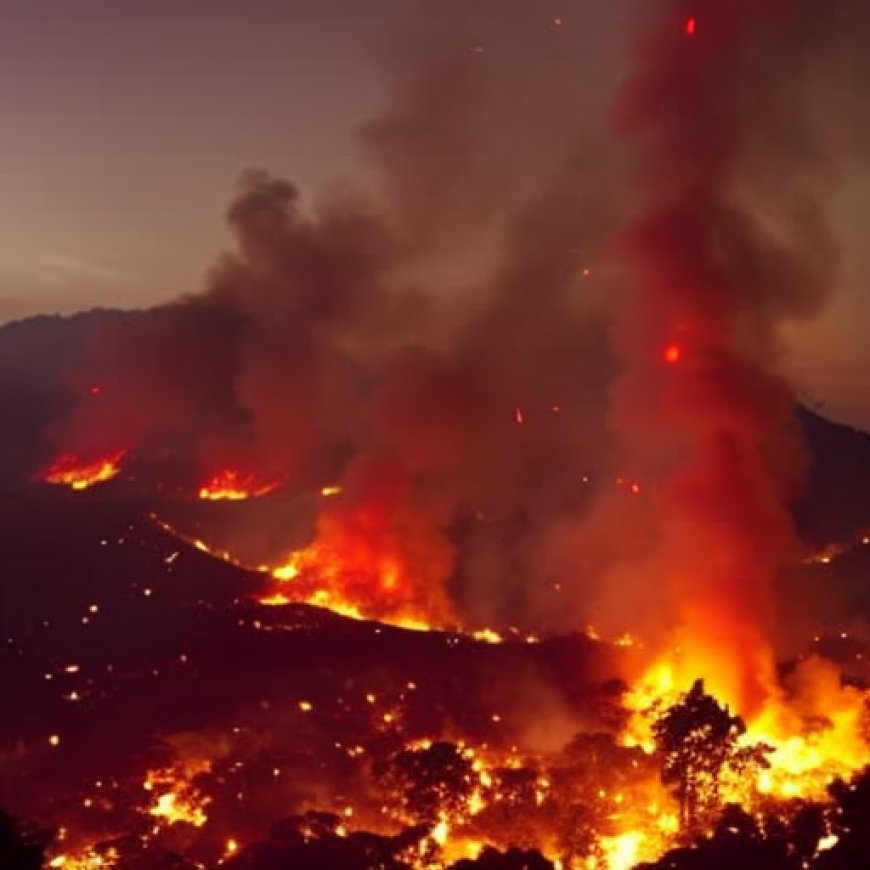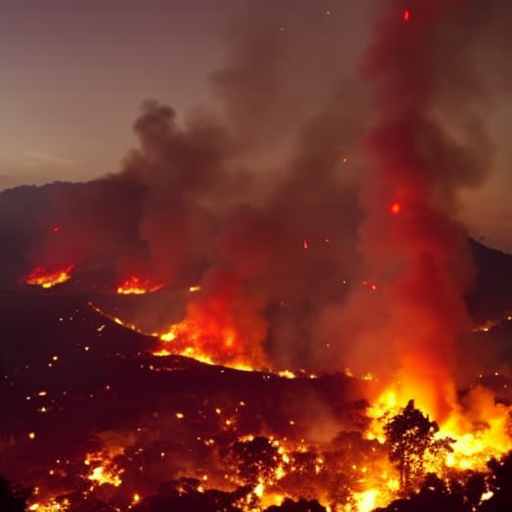Indonesia leads the way in taming forest fires
Indonesia leads the way in taming forest fires UN News


Volunteer Firefighter Battles Wildfires Alone
When volunteer firefighter Marlizar noticed smoke billowing over a quarter-hectare of peatland while on a routine patrol in 2019, he dispatched his colleague to their base in Riau province’s Teluk Maranti village, seven kilometres away, and faced the fire alone.
As Marlizar’s colleague sped off to retrieve a clunky hose unit, the 42-year-old attempted to beat back the flames with a tree branch while alerting the disaster management agency. Experience had taught him how to stay safe from smoke inhalation. “The only thing on my mind was what could I do to stop the fire from spreading,” he says.
Despite Marlizar’s valiant efforts, the flames had engulfed five hectares within an hour. In the two more hours it took for the hose unit to arrive—transported by speed boat, then hefted on several fire-fighters’ shoulders—the peatlands were ablaze as far as he could see.
In Teluk Meranti, in the following days and weeks, schools, airports, and government offices were forced to close as smoke thickened the air.
Losses in the Billions
Indonesia’s 2019 wildfires burned 3.1 million hectares, an area bigger than Belgium, blanketed six other countries in smoky haze, released almost 604 million tonnes of CO2 and caused some 900,000 people to report respiratory illnesses. The fires also inflicted $5.2 billion in losses in Indonesia, according to the World Bank, adding to the US$16 billion caused by even larger fires in 2015.
According to the UN Environment Programme (UNEP), worse is still to come; the UN body expects a 14 per cent increase in forest fires globally by 2030 due to a mixture of climate change and changing land use.
Integrated Fire Management Pilot Project
In Indonesia, a UNEP-led integrated fire management pilot project, financed by USAID, has, since 2021, helped build greater fire resistance in three of the country’s most fire-prone districts.
It draws inspiration from a “cluster-based” approach towards land management practiced in South Africa—bringing together the knowhow of community fire-fighting brigades like Marlizar’s, the reach of government agencies, and the resources of some of Indonesia’s largest private companies.
The project’s aim of enhancing coordination between community, government, and private land users could hold lessons for fire-prone countries around the world.
“Forest fires inflict massive humanitarian, environmental and economic costs, especially when they occur on carbon-rich peatlands, so it’s in everyone’s interest to prevent them from breaking out,” says UNEPs programme officer Johan Kief. “Indonesia has set ambitious goals on halting deforestation and reducing carbon emissions—reducing the risk of fires is a key component of achieving them.”
Preventing Fires through Collaboration
After UNEP began forming fire prevention clusters in 2021, no fire hotspots were found in the first pilot district, Central Kalimantan’s Pulang Pisau, in the 2022 dry season. In Riau’s Pelalawan district, where Teluk Maranti is located, the number of reported fires decreased from 139 in 2021 to 88 in 2022. In South Sumatra’s Ogan Komering Ilir district, the third pilot area, the number of reported fires declined from 345 to 109.
Based on the results achieved in the initial three pilot districts, the project is expanding to a further six priority districts, with the aim of eventually implementing the approach nationwide.
“The efficacy of collaborative approaches to fire prevention has been proven through these clusters. Sharing the experience of these three districts not just in Indonesia, but also to other peat-rich and fire-prone countries in Latin America and southern Africa, is a contribution from Indonesia to the world,” said Bambang Suryaputra, Head of the Centre for Operation Control at Indonesia’s disaster prevention agency, BNPB.
Addressing Resource Differences
At least 14 companies hold concessions in Palalawan district. One of the largest is paper and pulp maker APRIL, with some 150,000 hectares of acacia estate. Most fires in Palalawan break out on community rather than company land, APRIL’s deputy chief of fire and emergency response, Mr. Yuneldi says, but even when fires occur outside the company’s estate, APRIL has sent its ample resources, equipment, and personnel to assist the police and military in putting down fires.
Equipped with satellite imaging and real-time weather tracking technology, the resources at APRIL’s fire centre are a far cry from those available to community firefighters like Marlizar and his team, who gauge the dryness of the peatland they patrol by the way it falls through their fingers.
It is these differences in resources that UNEP’s cluster approach is designed to address, through developing an integrated strategy to take on a challenge that affects everyone.
In Teluk Meranti, community-based awareness raising efforts are paying off: new signage cautions fishers and bird hunters against tossing cigarette butts or starting cooking fires, and farmers have a better understanding of the risks involved in burning dry peatland.
SDGs, Targets, and Indicators
-
SDG 13: Climate Action
- Target 13.2: Integrate climate change measures into national policies, strategies, and planning
- Indicator 13.2.1: Number of countries that have integrated climate change measures into national policies, strategies, and planning
-
SDG 15: Life on Land
- Target 15.2: Promote the implementation of sustainable management of all types of forests
- Indicator 15.2.1: Progress towards sustainable forest management
- Indicator 15.2.2: Number of countries that have halted deforestation and restored degraded forests
-
SDG 17: Partnerships for the Goals
- Target 17.6: Enhance North-South, South-South, and triangular regional and international cooperation on and access to science, technology, and innovation
- Indicator 17.6.1: Number of science and/or technology cooperation agreements and programmes between countries
Analysis
The article addresses the issues of wildfires in Indonesia and their impact on the environment, economy, and public health. The following SDGs are connected to these issues:
SDG 13: Climate Action
The article highlights the increase in forest fires globally due to climate change and changing land use. Target 13.2 aims to integrate climate change measures into national policies, strategies, and planning. The article mentions Indonesia’s ambitious goals on halting deforestation and reducing carbon emissions, which are key components of achieving SDG 13.
SDG 15: Life on Land
The article discusses the impact of wildfires on forest cover in Indonesia, which has the third largest area of forest cover in the world. Target 15.2 focuses on promoting sustainable management of all types of forests. The article mentions the project’s aim of enhancing coordination between community, government, and private land users to prevent forest fires.
SDG 17: Partnerships for the Goals
The article highlights the collaborative approach taken by the UNEP-led integrated fire management pilot project, which brings together community fire-fighting brigades, government agencies, and private companies. Target 17.6 aims to enhance regional and international cooperation on science, technology, and innovation. The article mentions the project’s potential to share its experience with other peat-rich and fire-prone countries in Latin America and southern Africa.
Based on the information provided in the article, the following targets and indicators can be identified:
Target 13.2: Integrate climate change measures into national policies, strategies, and planning
- Indicator 13.2.1: Number of countries that have integrated climate change measures into national policies, strategies, and planning
Target 15.2: Promote the implementation of sustainable management of all types of forests
- Indicator 15.2.1: Progress towards sustainable forest management
- Indicator 15.2.2: Number of countries that have halted deforestation and restored degraded forests
Target 17.6: Enhance North-South, South-South, and triangular regional and international cooperation on and access to science, technology, and innovation
- Indicator 17.6.1: Number of science and/or technology cooperation agreements and programmes between countries
Table: SDGs, Targets, and Indicators
| SDGs | Targets | Indicators |
|---|---|---|
| SDG 13: Climate Action | Target 13.2: Integrate climate change measures into national policies, strategies, and planning | Indicator 13.2.1: Number of countries that have integrated climate change measures into national policies, strategies, and planning |
| SDG 15: Life on Land | Target 15.2: Promote the implementation of sustainable management of all types of forests |
|
| SDG 17: Partnerships for the Goals | Target 17.6: Enhance North-South, South-South, and triangular regional and international cooperation on and access to science, technology, and innovation | Indicator 17.6.1: Number of science and/or technology cooperation agreements and programmes between countries |
Behold! This splendid article springs forth from the wellspring of knowledge, shaped by a wondrous proprietary AI technology that delved into a vast ocean of data, illuminating the path towards the Sustainable Development Goals. Remember that all rights are reserved by SDG Investors LLC, empowering us to champion progress together.
Source: news.un.org

Join us, as fellow seekers of change, on a transformative journey at https://sdgtalks.ai/welcome, where you can become a member and actively contribute to shaping a brighter future.







